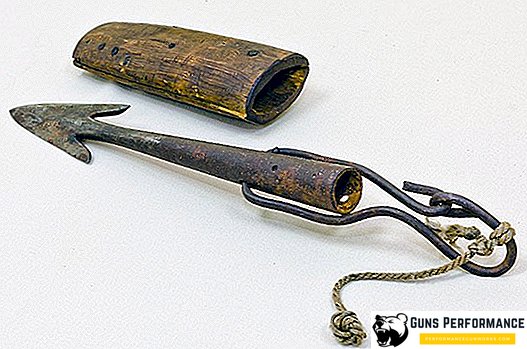Argued that the harpoon is something like a spear (harpoon) for spearfishing. Often it is equated to a prison. And this is understandable, because almost no one uses classic harpoons when hunting or fishing “for fun”. However, the northern indigenous peoples living through traditional crafts to date, use this tool.

In more civilized Europeans and Americans these days harpoon guns are in the "authority". However, they have practically nothing to do with ancient tools. They are quite complex tools that have undergone significant modifications over many centuries of their lives. Naturally, the whaling harpoon, which had a detailed description of Herman Melville, was particularly famous. Nevertheless, it is known about others, different in their designs and purposes.
What does the word "harpoon"
In the dictionaries you can find that the very concept of "harpoen" owes its appearance to the Dutch whalers, who in the XVII century had no equal. The word itself has a late Latin origin from the word harpo ("hook"). Nevertheless, there is information that this word was previously used by the Basques in one of the Spanish regions. From the Basque language the word "harpoon" can be translated as "stone edge". The old Russian name of a harpoon is a snout or a needle.
Harpoon and spear design features
The simplest device has a harpoon for fishing. This harpoon has the appearance of a serrated spear. Some harpoons have rings for attaching to boats. Harpoons can sometimes be called jails or vice versa. However, in reality, spears are somewhat different tools. They have several long teeth and are not throwing weapons. The hunters beat them to the fish without releasing the shafts from their hands.
Hunting with a harpoon looks a little different. Harpoons for hunting marine animals are throwing tools. They consist of shafts (usually wooden), tips (bone, stone or metal) and the ropes connecting them. In an atmosphere of lack of raw materials, as well as tools, hunters do not just make such harpoons.

The tips are usually flat and serrated are inserted into the shafts, but do not connect with them closely. Following the throw, the shafts are separated from the tips that are included in the bodies of the victims. In this case, it was not so often able to kill animals with a single throw. Wounded animals, trying to hide, pulled the rope, and the shafts floating on the water surface, indicated to the hunters the directions of their movement. They could not get rid of the victim’s points stuck in the bodies because of an obstacle from the side teeth.
Harpoons in the service of different nations of the world
Harpoons are international instruments. How to make a harpoon knew even primitive people. They learned how to make them and use them even during the Paleolithic. Initially they were made from bones (northerners - from walrus or mammoth) and horns, usually deer. The edges in the ancient harpoons of the Eskimos, Aleuts, Chukchi and Koryaks were silicon, bronze, copper and iron. Although, for example, in Alaska there were also solid wooden harpoons.
In some African tribes, harpoons with iron spikes are used to hunt hippos, and Andamans use wild boar. The caves of the European continent (far from the sea) are full of bony tips from not as simple as harpoons. They could be used, apparently, for hunting large or forest animals.
It is also known about the bone tips of the Neolithic era on the territory of our country. Hunting with harpoons conducted all year round. Hunted by boats on the rivers or scour. Ancient Indonesians used harpoons to mine whales, dolphins and sharks. Structurally, they did not provide for the separation of tips, they were only tied to the boats with long lines. Indonesians have a special style of hunting. They do not throw the harpoons at the whales, and, not letting the shafts out of their hands, jump on their backs and stab them.
Harpoons - Ancient Whaling Guns
Harpoon configuration was the most diverse. Classic European or American whaling tools have iron shafts and wide short blades. Most often, these harpoons have wooden arms, for them very long ropes were tied to boats.
From the six-meter distance, the harpooners threw their guns at the whales. At the time of the throws, the tips were not separated from the shafts. Vervka, tied to the harpoons, quickly unwound, and the whales swiftly pulled the boats through the waves, until they got tired. At that moment, the whales were finished off, but not by harpoons, but with a spear, and this was done not by a harpooner, but by the whaleboat captain. Although good harpooners enjoyed great respect. In the North, hunters still find in the bodies of whales remnants of twisted guns of the XIX century.
The formation of harpoons

From the second half of the 19th century, whaling harpoons were replaced by harpoon guns, which were invented by the Norwegian engineer Foin. This invention has made whaling less dangerous. Ordinary harpoons evolved into underwater guns. There was even a harpoon for a crossbow. However, these devices preserved the main features of their "ancestors", namely sharp tips with the presence of teeth, directed in the opposite direction, and cables that prevent hunters from missing the catch.
The northern indigenous peoples still have the same tools as their forefathers. In general, harpoons are universal field tools. Despite the fact that the Aleuts and Chukchi have long possessed firearms, they still do not reject traditional methods and tools tested by centuries.
How to make a harpoon at home
At home, it will be easy to learn how to make a homemade harpoon, for example, for underwater hunting. Typically, these devices consist of handles and tips. Before you make a harpoon, it is advisable to prepare and purchase all the necessary materials.
To make a homemade harpoon at home, as an option, you will need the following items:
- Wooden stick;
- Segment of a polypropylene tube;
- Glue;
- Martens bandages;
- Medium sized nails;
- Threads;
- Large nut;
- Vice;
- Sandpaper;
- File;
- Handsaws;
- Electrical tape.

Initially proceed to the manufacture of the harpoon itself. For this purpose, the nut is placed in a vice. At the same time, a wooden block is attached to the drill. Using medium speed, the bar must be inserted into the nut and scrolled through it to achieve a round configuration.
Further, in the same way, with the help of a scrolling drill, it is necessary to grind a wooden bar with emery paper. Then nails are taken up to three units, caps are sawn off with a hacksaw, and with a help of a file, two ends are sharpened on each nail in order to achieve their maximum sharpness.
At one end of the bar you need to wind the tape, alternately attach nails to it with a strong thread of fishermen. Then smaller bars are inserted between them and the stick so that the nails become at an angle. The space between the nail and the bar for reliability pour glue. Next, the place where the nails are jointed is taped with electrical tape. That's all, the harpoon is ready.

Next is the main part for starting the harpoon. For this, a piece of martens bandage is cut off and glued to a polypropylene pipe at both ends. From above this part together with the place of contact of the harpoon with the bandage should be wrapped with several layers of electrical tape. Then the harpoon is attached with a fishing line or fishing thread to the starter to hold the prey.












